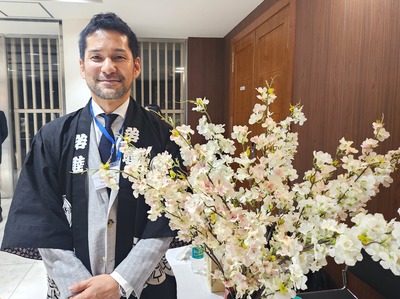Simplified laws, low customs duty to induce consumption of Japanese wine sake in India: Kojiro Honda
Currently total export of sake from Japan to India stands at JPY 46 million a year, which is very small as compared to China and USA probably less than 1%.
NEW DELHI: The Japanese Liquor Import Coordinator for India appointed by Japan’s National Tax Authority recently, Kojiro Honda has said that simplification of statutory regulations and reduction of customs duty will induce consumption of Japanese premium wine sake in India.
If complicated laws prove to be deterrent for the Japanese sake companies to enter Indian market, high customs duty on sake makes it very costly preposition for the Sake lovers resulting in limited consumption, said Kojiro Honda who has been operating a successful Japanese restaurant chain, Kuuraku, and is co-owner and founder of Hirohama India and Kuuraku India. He has a fair idea about the Indian palate and opportunities for Japanese sake which is an integral part of Japanese culture.

Honda said, “Currently total export of sake from Japan to India stands at JPY 46 million a year, which is very small as compared to China and USA probably less than 1%. But the demand is very high as I am running a chain of Japanese restaurants. Many customers ask for sake but sometimes becomes out of stock. Youngster especially in Mumbai and Bengaluru are drinking sake very much in India even though the cost of one 300 ml bottle of sake is INR 4000. They know that it’s a premium Japanese liquor and they understand the Japanese culture and therefore understand why sake is so expensive.”
According to industry reports, the total export of sake from Japan to India is estimated JPY 46 million as against 14.16 billion yen to China followed by 10.93 billion yen to the USA. Export to India is less than 1 %’s of China. Japanese sake is becoming increasingly popular in China as a high-end alcoholic beverage, particularly among the young and wealthy demographic.
While detailing factors affecting the import of sake to India, he said, “Import regulations in India are very tricky as well as customs duty is very high at 150%. The customs duty on sake should be under 30% as if the price goes down more people can afford it and consumption will shoot up.”
Related article: China stumps US to 3rd position in consumption of Japanese wine Sake as top consumer, ends its 8-yr old supremacy
While giving examples, Honda said that regulations especially in Delhi and Haryana states very tricky. He said, “Labeling here is very tedious process and takes quite a long time while it is very easy in Maharashtra, Karnataka and Goa. As example, in Gurugram, Restaurant is required to buy sake only from the nearest vend whereas it should be left at the discretion of the restaurant owner to source sake from whichever vend he likes at competitive rates. There should be one regulation all over the country.”

After being appointed as a Coordinator in August last year to promote sake export from Japan to India by increasing awareness, organizing business meetings and events, Honda recently led a delegation of seven sake companies from Japan and organized “Japanese alcoholic beverages Overseas Business Meeting” at the Embassy of Japan in New Delhi. The Indian liquor importers were invited to this B2B meeting and sake tasting session as they closely interacted with the representatives of companies from Japan.
The reigning Miss Sake Japan (2023) Ms. Kotoko Yamada also accompanied the delegation as she provides consulting services to Japanese companies on the overseas expansion of their businesses in her day job. She delivered useful tips about sake to the Indian importers. Ms. Yamada made the participants visitors learn about the variations in the taste of sake resulting from rice from the Tohoku to Kyushu regions. Her lecture focused on the different types of sake, such as nama-shu, seishu and koshu, making it for the participants understanding the differences in the way they drank and tasted sake, and learned what sake was all about and its depth.
Hiroshi Suzuki, Ambassador of Japan to India also attended the meeting and madean inaugural speech. Ms. Nupur Tewari from Japan held an interview-style seminar with lecturer Yamada san on how to make Japanese alcoholic beverages easier for Indians to drink.
Ravi Joshi, Founder of Sake Club India and a certified sake expert said that the event was a grand showcasing of Japanese Sake, Shochu, Awamori and Rum took.
“The range of sake showcased at the event was quite diverse. Apart from the expected Junmai, Ginjo, Sparkling, Umeshu (Plum Liqueur) and Nigori (Cloudy Sake) categories, there was also the highly niche Yamahai, Kimoto, a Sake based red liqueur matured with recycled sakura (cherry) wood sticks and a zero alcohol Amazake. One of the producers also brought in some inspiring distilled Japanese alcohols like Awamori, Shochu and a Rum from Okinawa island.”
Related article: Doon valley girl Kajal Chauhan wears Miss SAKE India 2024 crown, loves Japanese culture
The CHIGONOIWA Sake Brewery CO. LTD. Showed up with chigonoiwa karakuchi-junmai, chigonoiwa jyo-sen, and capbara umesyu; Miyazaki Syuzo with Gin-no-mai and sumari, Mika Sake Global Inc. with Kamikokoro KokagenoSakana, Kagatsuru Plum Sake, and Yonetsuru Junmai Andante; and NOZOMI JAPAN showcased Hirokimono Iwau, and Shirokimono Omou.
Usui Shoten Co., Ltd. presented Monsay Junmai Ginjo, Monsay Junmai Daigiinjo, and Monsay Kimoto Junmai; Amabuki Shuzo Co.,Ltd. Amabuki Kimoto Junmai Daiginjo, Amabuki Yamahai Junmai, and Amabuki Cloudy Junmai Cloud, while Japonte Ltd. presented AQ, Danryu 3-year-Old 40 degrees, and Satsuma Shiranami 37.


